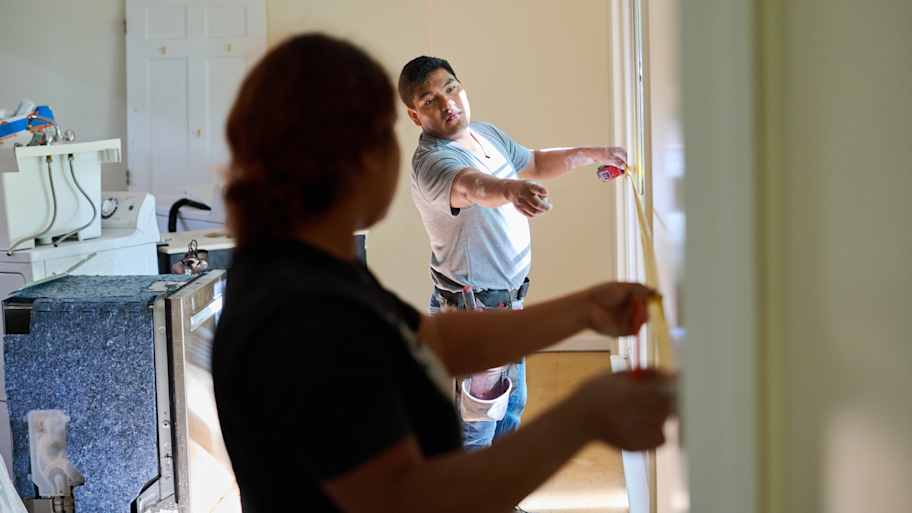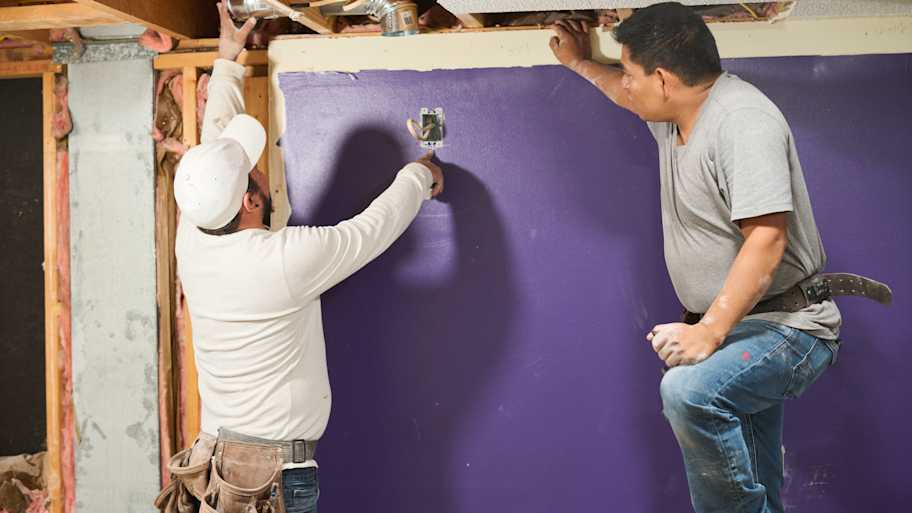How to Patch a Hole in Drywall in 10 Simple Steps
You’ll be a patching pro in no time


- Dust mask
- Safety goggles
- Drop sheets
- Damp cloth
- Dry cloth
- Drywall patching kit
- Bucket of water
- Paint
- Paintbrush
Drywall is notorious for collecting dents, holes, and cracks, which can tarnish the look of your home. Even worse? In some cases, drywall damage can compromise your insulation or let pests inside. Thankfully, learning how to patch a hole in drywall is easy—as you’ll see below.
Gather Your Supplies
Your kit will come with all of the drywall repair tools you’ll need to patch a small hole (up to 5 inches across), including a putty knife, sandpaper, and spackle. However, it’s also important to grab a pair of safety goggles and a respirator mask to protect your health.
Measure the Hole
In addition to the tools mentioned above, drywall repair kits also include mesh patches to cover the holes in your wall. Since these patches come in various sizes, you’ll need to know the diameter of the hole you’re patching before purchasing a kit.
Prepare the Area
 Photo: SrdjanPav / E+ / Getty Images
Photo: SrdjanPav / E+ / Getty ImagesDrywall can make a big mess, so we recommend covering your floor and nearby furniture with drop sheets before getting started.
To kick off the drywall repair work, use a damp cloth to wipe down the area around the hole, making sure to get rid of any dirt or dust on the wall. Then, dry everything with a clean cloth.
Using the sandpaper from your kit, sand around the hole to smooth out any uneven edges.
Prepare the Spackle
Many drywall patch kits include premixed spackle. If that’s what you have, give it a gentle stir and move to the next step.
Otherwise, if your spackle came in powdered form, mix it with water according to the instructions on the package.
Position the Wall Plate and Patch
Some kits include a flexible plastic plate that you insert into the hole for extra stability. If you have one of these plates, attach it to the back of the wall.
No matter what kind of kit you have, the next step is often the same: Stick the self-adhesive mesh patch over the hole in your drywall. If the patch is much bigger than the hole, you can trim it with scissors.
Alternatively, if the patch isn’t large enough to cover the entire hole, you’ll need to buy bigger patches. Online retailers and home improvement stores sell individual drywall patches.
Spread Spackle Over the Patch
 Photo: totalpics / iStock / Getty Images Plus / Getty Images
Photo: totalpics / iStock / Getty Images Plus / Getty ImagesUse the putty knife to apply spackle over the mesh, extending it past the patch by an inch on each side. Spread the spackle in a crisscross pattern, making sure to cover the patch completely and feathering the edges to mask the texture of the mesh.
Clean the putty knife in the bucket of water to get rid of any leftover spackle.
Let It Dry
Now, you’ll need to exercise a little patience as you wait for the spackle to dry. Depending on your kit, this could take anywhere from 15 minutes to 24 hours. Check your kit’s packaging to find the manufacturer’s drying time recommendation.
Apply a Second Layer
Repeat the steps above to apply another layer of spackle on top of the first one. This will be your top layer, so aim to make it as smooth and bump-free as possible.
When you’re done, let it dry according to the manufacturer’s instructions.
Sand the Area
 Photo: Alexandre Morin-Laprise / Moment / Getty Images
Photo: Alexandre Morin-Laprise / Moment / Getty ImagesWhen the spackle is dry, use the kit’s sandpaper to sand the area smooth. Wipe the wall with a damp cloth to get rid of any dust.
Paint the Wall
Use a paintbrush and paint to touch up the patched area. (Note: If you’re patching lots of holes or find that the patched area doesn’t blend in well, it’s better to repaint the entire wall.)
DIY vs. Hiring a Pro
Patching one or two small holes in drywall is a beginner-friendly DIY task. When you tackle this project yourself, your only expense will be the drywall repair kit, which costs between $10 and $30. Meanwhile, hiring a professional to repair small drywall holes costs $20 to $120. Fixing larger holes is often more expensive, ranging from $50 to $200.
With that said, if your drywall is full of holes or in otherwise poor condition, consider hiring a drywall repair pro near you. Depending on the type and extent of the damage, they might have to repair or replace large sections of the drywall.
Frequently Asked Questions
When used correctly, drywall patch kits can work well. However, there are limitations. Specifically, these kits can only cover holes up to 5 inches in diameter. For anything larger than that, you’ll need to cut out the affected section of drywall and replace it with a new piece. That’s a far more complicated process that involves buying the right type of drywall, finding the wall studs, cutting into your wall, and screwing the replacement drywall in place.
If you only have tiny holes in your drywall (for example, dents or nail marks), you probably won’t need a patch kit. Instead, you can plug the hole with a small amount of spackle. Once the spackle dries, you can sand the area and paint over it—just like you would in the steps outlined above.
You might hear the terms “Sheetrock” and “drywall” used interchangeably, but there’s an important difference. Drywall is a building material that covers interior walls and ceilings. Sheetrock, however, is a brand name of drywall (like Kleenex is a brand name of tissues). In other words, all Sheetrock is drywall, but not all drywall is Sheetrock.





- 11 Must-Know DIY Drywall Repair Tips
- How to Repair Water-Damaged Drywall
- 8 of the Most Common Drywall Problems and How to Solve Them
- When Should You Hire a Pro for Drywall Repair vs. DIY?
- Who Should You Call For Drywall Repairs?
- Who Installs Drywall? Get the Right Pro for the Job
- How to Dispose of Drywall When You’re Done With a DIY
- Tools for Drywall: A Complete List for DIYers
- How to Cut Drywall Before and After Hanging It
- Who Patches a Wall After Plumbing or Electrical Work?















